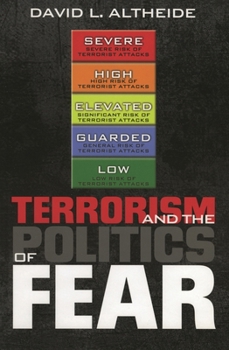Terrorism and the Politics of Fear
Select Format
Select Condition 
Book Overview
This text explains how the social construction of fear is used to steer public and foreign policy, arguing that security policies to protect the citizenry have become control systems that curtail... This description may be from another edition of this product.
Format:Paperback
Language:English
ISBN:0759109192
ISBN13:9780759109193
Release Date:May 2006
Publisher:AltaMira Press
Length:264 Pages
Weight:0.90 lbs.
Dimensions:9.1" x 1.1" x 6.1"
Customer Reviews
1 rating
Fear Not! A Captivating Read Indeed!
Published by Thriftbooks.com User , 19 years ago
Terrorism and the Politics of Fear (2006) David L. Altheide Altheide's work for the past thirty years has dealt primarily with the proliferation of the mass media and its growing place in our everyday public lives. Terrorism and the Politics of Fear expands on his recent research over the past decade involving fear; tracking its expansion throughout the mid 1990s, ultimately giving rise to what he calls the `discourse of fear,' or `the pervasive communications, symbolic awareness, and expectation that danger and risk are all around us' (page 11). The discourse of fear is fully explicated in his previous book, Creating Fear: News and the Construction of Crisis (2002) and serves as the theoretical catalyst for many of his arguments in Terrorism and the Politics of Fear. The crux of Terrorism and the Politics of Fear involves social power, or the ability to define a situation and others and the role that the mass media play in this process. The book posits that authorities (e.g. formal agents of social control) promote fear, via the discourse of fear among citizens on the basis, "that even the cynical observer [will] hand over their lives for protection" (page 2). It is important to note that his argument rests on the assumption that fear is not necessarily good nor bad, but rather is maintained through everyday interaction; thus the concern then is understanding how fear is promoted, especially politically (e.g. the `politics of fear') which yields key insights into how fear is employed through such avenues as propaganda. The `politics of fear' refers to, `decision makers' promotion and use of audience beliefs and assumptions about danger, risk, and fear in order to achieve certain goals' (page 15). Throughout the text Altheide reveals through meticulous detail how the politics of fear is A) informed by the discourse of fear and B) how the two become inextricably linked. This linkage is the basis of contemporary forms of social control facilitated most notably through the mass media. For example, this linkage is bolstered through perpetual images of fear by entertainment media; that rely heavily on a `fear format' which is informed by media logic, or `the process through which media present and transmit information (page 50). Increased technologies give rise to increased surveillance, however this book highlights that the problem is not necessarily with surveillance, increased presence of formal agents of social control, or the like; rather the concern becomes spotlighting changes of symbolic representations in the social order which help us understand accompanying shifts in television programming, such as war programming (see chapter 8). Fear (among other things) sparks consumerism and this book effectively demonstrates how people are more likely to be regarded as audiences (rather than individuals), which as Altheide suggests in turn accounts for the disappearance of citizenship in our mass-mediated age. This book is highly recommended.





